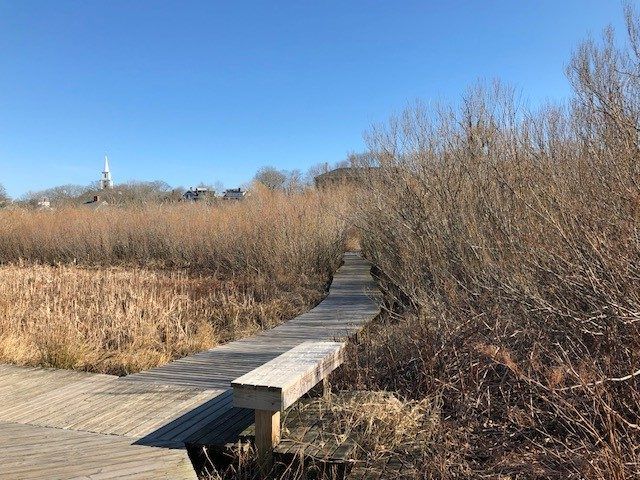The Lily Pond
I love this view. It seems like a never-ending tunnel of swamp, decking, and plant-life. This particular day, I could hear children at the other end – it was an unseasonable warm day for February and parents and daycare providers were bringing children to picnic and enjoy the warmth and sun. I also love seeing the Congregational Church and Academy Hill School when in the Lily Pond – it’s a bit of a jolt – you forget you are in Town almost.
What you might not know is that this “pond” as it is referred to was for lack of a better word, destroyed by a child. Oops!
You see, Lily Pond was once an actual pond with at least one mill. We do not have rivers or powerful streams here that can power mills but the Lily Pond once boasted at least this one water mill. The Pond had an outlet that ran to the harbor and islanders built a dam to control the flow of the water. This was in the late 1600s/early 1700s. But one morning, people awoke to find that the Pond had emptied overnight.
A young girl named Love Paddock, who lived nearby (I’m assuming at what is today the Oldest House as Paddocks lived there but I haven’t delved into that research), decided as all children do, to play in the water one day – she likely did it quite a bit. I myself remember playing with water that drained from our basement. We lived in a wonderful 1920s colonial revival when I was young and I suspect the area was filled with springs but our house had the most amazing drainage that brought water out through our “woods” – a wooded corner – and down to the neighboring street where I could dam it up and play with it among the rocks. In any case, Love decided to play and carved tiny rivulets that led away from the Pond. When finished with playing, she left and went home. It was not until the next day that she saw what her “harmless” playing had done – the Lily Pond was no longer – all the water was gone. But as many a child would, she kept her deed to herself. Until , she was on her deathbed.
Love lived to be a very old woman. She had created the rivulets when she was about ten years old or so – about 1720. It was not until she lay dying that she made her confession and people learned of why the Lily Pond was drained to basically become what we see today. I am sure that Maria Mitchell was well-aware of this story.
The story is further enhanced that the Town tossed pieces of the former Nantucket Railroad into the Pond area when the railroad was dismantled. Thus clogging it up a bit more. The area is basically a marsh, not a pond, now but it attracts an incredible array of bird, plant, and wildlife, including human life. So I guess we cannot be entirely dismayed by Love’s actions, though I think the people of her time may still hold a grudge wherever they are!
JNLF
Recent Posts





